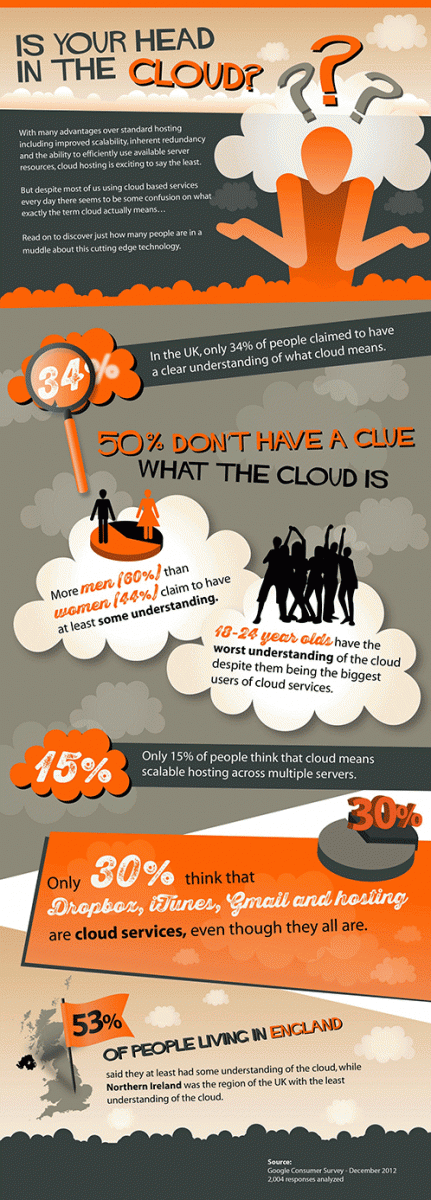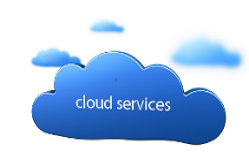Blog posts tagged cloud computing
Ten ways cloud computing can help your small business
 Cloud computing has long been a mainstay of the biggest businesses but it is increasingly being embraced by even the smallest firms. If you are yet to take the plunge, here are ten ways that cloud-based software solutions could benefit your small firm right now:
Cloud computing has long been a mainstay of the biggest businesses but it is increasingly being embraced by even the smallest firms. If you are yet to take the plunge, here are ten ways that cloud-based software solutions could benefit your small firm right now:
1. Providing greater flexibility
Small businesses are often far more agile than larger corporations, so why would you want to undermine that advantage by failing to tap into the cloud? Cloud computing gives you instant access to the latest applications and allows you to take advantage of system support that meets your exact needs and grows with your business.
2. Reducing capital expenditure
Recent years have seen a shift in emphasis from a capital expense (CapEx) model to an operational expense (OpEx) one, on account of the minimal upfront investment and zero long-term financial commitments associated with the latter. Cloud computing equips your small business to start projects faster, end them with fewer financial complications and keep ongoing expenses predictable.
3. Greater collaboration and communication
The cloud liberates your employees to work together more productively, even if they are out of the office or based on the other side of the world. It means that your personnel can sync up and work on shared documents and apps at the same time, with critical real-time updates being provided to everyone working on a project.
4. Boosting security
It's common these days for millennial employees to carry work-related information around with them on their laptops wherever they go. With the cloud, much more of your sensitive business data is stored in one, secure place - namely a cloud server - allowing you to keep it away from prying eyes.
5. Maximising your environmental friendliness
It's more important than ever these days for your company to be seen to be socially responsible and sensitive to the environment. A cloud computing solution can certainly make a big contribution to this goal, as it enables you to only use the amount of server space and energy that you actually need, minimising your carbon footprint. Using the cloud reduces energy consumption and carbon emissions by at least 30% compared to on-site servers.
6. Ensuring greater document control
Once upon a time, small businesses working on an assignment would have had to exchange emails back and forth containing sensitive and valuable information. Not surprisingly, more and more small firms are embracing the chance to keep control of their documents under the "one roof" of their cloud server. Document control is set to become an ever-more important issue as more knowledge workers collaborate with colleagues remotely.
7. Recruiting the best talent
The internet age has enabled more of us to work from anywhere, making geographical location less of a barrier to collaboration. Cloud computing has played a key role in making this possible. A recent study has found that 42% of working adults would even give up some of their salary if they could telecommute; embracing the cloud could help your business to attract the very best talent.
8. Faster disaster recovery
Any downtime for your company can incur significant expense, and it is often the smallest businesses that risk having to cease trading altogether due to unforeseen events such as fire or flood. With the cloud, you can be back in action fast and neither you nor your customers need to be compromised for long. If you need any further convincing, Aberdeen Group found that businesses using the cloud are able to resolve issues in an average of 2.1 hours, compared to eight hours for businesses not using the cloud.
9. Automatic software updates
Did you know that in 2010, UK companies spent 18 working days per month managing on-site security? The need to remember and fork out for updates related to your many software packages is one of the most compelling reasons to switch to the cloud. It means that you can focus on more important matters like building your core business, as regular software updates are automatically rolled out for you.
10. Slashing tech infrastructure spending
The latest hardware and software costs money, often upfront. By investing in cloud migration, you can spend very little upfront, paying as you go in accordance with your needs at any one time. With cloud computing, it couldn't be easier, faster or more cost-effective to upscale or downscale your infrastructure.
It's easy to see why the worldwide cloud computing market commanded a whopping $110 billion in revenues in 2015 - it is simply relevant to almost every kind of small business. And the sooner your small firm embraces the cloud, the better equipped it will be for the emerging age of the Internet of Things.
Sponsored post, copyright © 2016 Red Pixie, a cloud computing specialist. Red Pixie also offers a guide to the cloud for CFOs.
Four reasons to move more of your business to the cloud
 We're long past the point where 'the cloud' was just another piece of technology jargon. Businesses of all sizes are adopting the cloud as part of their everyday strategies.
We're long past the point where 'the cloud' was just another piece of technology jargon. Businesses of all sizes are adopting the cloud as part of their everyday strategies.
And it's not the complex entity that many smaller companies fear. In fact, it can be a reliable, straightforward way to store data. It can also make you more productive, thanks to its ability to offer unhindered access to real-time information.
It's very likely that parts of your business already run on the cloud. There may be a strong argument for moving more of it there. Here are four reasons to get you thinking.
1. Ditch your usual IT refresh cycle
Technology is crucial to your business, but storing and handling data can place serious demands on your IT resources. Keeping your IT up to date in the face of ever-increasing processing requirements is tricky.
But cloud computing can revolutionise how you approach refreshing and replacing hardware and software in your business.
Typically, IT infrastructures are reviewed every three to five years. If replacement hardware is required, this can be costly.
When you switch to the cloud, you get a stable, predictable solution that requires fewer manual updates and less maintenance overall (that's because your cloud provider should take care of these items). It also relieves you of the burden and cost of servers and other equipment.
2. Get improved accessibility
The cloud gives you continual access to your business systems. They can be accessed any time of the day, from any location (as long as you have an internet connection).
If you have sales teams on the road or people who tend to work from home, this accessibility makes it easier to stay in touch, coordinate work and give people access to what they need.
What's more, this accessibility is only set to improve. Fast 4G mobile networks are spreading across the UK, and public Wi-Fi is available more widely than ever.
At the same time, the way teams work within a business is changing. The number of remote workers is increasing. Give them access to the cloud and they can be much more productive. For instance, automatic document uploads make it much easier to work together.
This gives you a competitive advantage in many ways. With location less of a barrier, you can access a pool of talent that stretches across the country, or even the globe. Remote working can make your employees happier, too – leading to increased staff retention.
3. Stop worrying so much about security
When serious breaches happen, they're big news. High-profile hacks have placed cloud computing under scrutiny, encouraging providers to boost security measures and test them regularly.
Although private cloud services are a good option if your business needs to store really sensitive data, cloud services generally offer excellent security.
Most providers implement strong physical security, with round-the-clock monitoring and surveillance. Other measures to protect servers include high perimeter fences, bollards, security checkpoints, biometric security controls, and 24/7 security teams.
Together with active monitoring that identifies and blocks network attacks - plus automated backups - using the cloud can dramatically improve security.
Richard Kennedy, head of cloud computing at The Cloud Simplified, explains further:
"When migrating to the cloud, security is a common concern. Where is my data located, who has access to it and what measures are in place to protect it?"
"If your business has a noisy, dusty server sitting in the corner of the office, consider this: how safe is your data right now? What's stopping someone from physically removing it from your premises and what measures are in place to protect your information from a disaster or human error?"
4. Make your costs more manageable
Moving everyday business data and processes to the cloud can deliver significant savings. For starters, it reduces the need for in-house equipment, cutting your energy costs.
Additionally, running servers in-house usually means investing heavily in maintenance and support. By moving to the cloud, you reduce this expenditure. Most cloud services require minimal outlay upfront. You just pay a regular monthly fee.
Finally, cloud computing protects your business from IT-related financial loss by reducing the risk of hardware failure from incidents such as fire, flood or break in.
The capabilities of cloud computing have progressed enormously even within the last three years. If your business isn't ready to leap to the cloud, you can move in small increments instead. As your knowledge of and trust in the cloud builds, you'll start to see your entire company benefit.
Copyright © 2015 Rebecca Moore
Does your business need a cloud strategy?
 If you're looking for a short answer as to whether your business needs a cloud strategy, the answer is simple: yes. Read on to find out why
If you're looking for a short answer as to whether your business needs a cloud strategy, the answer is simple: yes. Read on to find out why
Even if you plan to do nothing for now other than to watch your business grow and to monitor how cloud computing changes as your requirements shift, that's a strategy. But is it the right strategy for your business?
Cloud computing and storage have crept into organisations in many forms. Tools like Google Apps, Microsoft Office 365 and Dropbox mean that the cloud is commonplace.
These 'shadow IT' solutions are often implemented in a piecemeal fashion, as particular needs arise. But as the cloud becomes more sophisticated and your business needs evolve, you may need to use the cloud in a more organised, strategic manner.
We're (nearly) all using the cloud
RightScale's 2015 State of the Cloud Report found that 88% of enterprises are using public cloud services (like Dropbox), while 63% are using private cloud (this means their own cloud applications that aren't shared with other organisations).
These companies have adopted the cloud to enjoy some significant benefits:
- Agility. Cloud services can be set up quickly. This means you can get the IT services you need almost immediately, with no need to set up any major infrastructure, like new servers or software.
- Cost-effectiveness. Replacing out-dated hardware is expensive, particularly for key equipment like servers. With cloud computing, you pay a regular fee instead of a large fee upfront.
- Capabilities. Technology is still growing in importance in most businesses. Big data, better customer relationship management, improved ecommerce - the cloud can help in these areas, and more.
However, to see the biggest potential benefits in these three areas, you really need to plan ahead rather than just reacting.
So, what is your cloud strategy?
A successful cloud strategy won't stifle your company's agility. But will increase your understanding of how decisions about the cloud can affect and improve the work your people do.
When developing a cloud strategy, make sure you focus on aligning your IT services with the needs of your business. (If you haven't done this in a while, you can go back to the basics of your IT requirements, thinking about how technology can help you achieve your business objectives.)
Regardless of your specific objectives, it's a good idea to aim for:
- A standard operating environment (SOE). This means you have a single set of software and cloud services used across your business. With an SEO, it's much easier to manage security, patches and updates.
- A single SOE management platform across your business infrastructure. This allow you to manage, monitor and automate cloud computing functions from one place.
- A system that will allow you to add capacity and deliver increased availability more easily than the software and services you rely on currently.
- A faster way to set up new users, features or other capabilities. (For instance, you should be able to create a user account for a new employee quickly and easily.
- A lower total cost of ownership (TCO). Because cloud-based systems are generally more effective, you should see your total costs reduce over the long term. (You can measure these over a period of 3+ years.)
Of course, your strategy should evolve in response to technological advances or market changes. Understanding how to adjust your strategy is key for it to remain fit for purpose.
Can a cloud partner help?
Coming up with a suitable cloud strategy can be tricky. The demands of day-to-day tasks may mean it's one of those jobs that never gets done.
As with other aspects of choosing and buying IT, you might also benefit from getting an external perspective on things. An independent consultant or local IT company may be able to help you develop a practical, long-term cloud strategy.
Copyright © 2015 Simon Mitchell, CEO at LinuxIT
The cloud: good for your business, and the economy
 Cloud computing has been a game-changer for business IT. In the UK last year, 581,173 new businesses were registered with Companies' House. Certainly, part of this accelerated growth can be put down to cloud computing
Cloud computing has been a game-changer for business IT. In the UK last year, 581,173 new businesses were registered with Companies' House. Certainly, part of this accelerated growth can be put down to cloud computing
This is because cloud technology allows new ventures to be in business almost instantly. As a new company, you can get an IT infrastructure that would be far beyond your reach if you were required to buy and host it in-house.
This rapid deployment means new businesses can punch above their weight and compete with larger, more established peers almost immediately.
It may not seem as easy for established businesses to deploy cloud services. Research from the Federation of Small Businesses found that only a quarter of small firms are actually investing in technology such as cloud computing – even though they could reap many benefits from going down this route.
Overall, it seems new businesses are more willing to embrace these new technologies.
The barriers to entry for existing businesses
Around the world, many major businesses have already switched from on-site IT solutions to the cloud. And they're enjoying the advantages this brings them.
So, why are smaller companies holding back from this transition?
A survey from Oxford Economics (PDF link) found many small businesses are more interested in technologies such as business intelligence and mobile solutions rather than the cloud.
Additionally, some small business owners are scared of the cloud. Often, they have concerns about the costs, complexity and risks involved.
But cloud computing is changing how people do business. By ignoring the potential of this technology to evolve their own businesses, smaller companies are missing out.
It's essential they look at adopting the cloud. The productivity benefits it can bring may enable them to stay competitive. There are really four key areas to consider:
1. The cost of cloud computing
Cloud technology can deliver significant cost savings by reducing the need for in-house infrastructure. It also tends to reduce upfront expenditure and ongoing maintenance costs.
A report from the European Commission found that the adoption of cloud computing could result in 80% of organisations reducing their costs by about 10%-20%.
2. The benefits of pay-as-you-go
Many cloud computing services offer the option to pay monthly. When cash flow is important to your business, this can make a big difference.
Pay-as-you-go options also allow businesses to access sophisticated software with no upfront fees and no lock-in period.
3. Being able to stay flexible
Mobile technology means you can now do business anywhere there's an internet connection. Cloud computing lets your staff access applications and files on the go.
This can be good for all kinds of businesses. For instance, if your company employs freelancers or has employees who have to travel for work, this could keep them in touch.
The cloud is also helpful when it's difficult for staff to get into the office. You can run the company from anywhere, because you're not reliant on technology on your premises.
4. Staying secure
Security has long been a barrier to wider adoption of cloud computing. However, cloud providers can actually offer increased security at a lower cost than smaller companies could otherwise afford.
Put it this way: if you choose your cloud provider carefully (that's important), your data will be kept in a UK data centre. There, it'll be protected by security measures far in excess of what your business could implement, because the cloud provider's reputation hinges on keeping data safe.
The cloud will grow the economy
With their capacity to adapt in an ever-changing business environment, small companies are vital for continued UK economic growth.
Many innovative start-ups growing by making the most of what the cloud provides, but all businesses should be aware of its transformational potential.
If you run a smaller business, you need know-how to stay ahead of the game. What's more, the wider business and digital communities must work to encourage and support the adoption of new technologies, including the cloud.
Copyright © 2015 Steve Belton of InstaCloud
The myths and realities of cloud CRM

From multinational corporations to one-person businesses, it seems everybody’s moving to the cloud.
The numbers certainly confirm this trend: 69% of global data traffic will shift to new-style ‘cloud data centres’ by 2017, according to the Cisco Systems Global Cloud Index.
Customer relationship management (CRM) is at the forefront of the cloud boom. Up to 40% of CRM systems sold in 2013 were cloud-based, according to Gartner. So, if you’re still lagging behind, is it because you’re unsure about some aspects of the cloud?
If so, here are the four biggest myths about cloud CRM systems:
1. Your data won’t be secure
Small and medium-sized businesses often lack the internal resources to implement adequate security measures. However, the same companies are often concerned that the cloud will expose their data to greater threats.
Moving to the cloud does mean putting your faith in a third party. However, cloud providers are able to implement sophisticated firewalls, security protocols and data encryption. It’s unlikely that most smaller companies could protect an in-house system to the same level.
Learn more about cloud security >>
2. You can suffer uncontrollable outages
A survey conducted by Maximizer Software in 2013 revealed that 71% of small and medium-sized businesses fear outages and disruptions if they move to the cloud.
In reality, however, a large, dedicated service provider is much less likely to suffer breakdowns than a small, in-house IT department.
3. Small businesses can’t afford the cloud
It’s not just large corporations that can afford cloud technologies. Operating in the cloud can also cut costs for many small and medium-sized companies.
This is because no expensive infrastructure is required, security is largely handled for you — and costs for IT staff, power and maintenance are reduced.
4. The cloud means changing business processes
Many companies fear that moving to the cloud will affect their business for the worse. While it might take a little while to adapt to a new cloud system, over time it can pay dividends.
Improved collaboration, easier data access, convenient offsite working and new ways of tapping into business intelligence can all result from moving to the cloud.
So yes, you have to change some processes. But those changes should be for the better.
Of course, it pays to be cautious before adopting any new technology platform. However, sooner or later the cloud will become a reality for most of us. Why lag behind?
- How do businesses use cloud computing?
- How CRM and IT are moving to the cloud
- Six questions to ask about your new CRM system
Copyright © 2014, Mike Richardson, managing director for EMEA at Maximizer Software.
Why the cloud is like a serviced office
 “If someone asks me what cloud computing is, I try not to get bogged down with definitions. I tell them that, simply put, cloud computing is a better way to run your business.”
“If someone asks me what cloud computing is, I try not to get bogged down with definitions. I tell them that, simply put, cloud computing is a better way to run your business.”
That’s the cloud, according to Marc Benioff, CEO and founder of cloud business platform Salesforce.com.
And while you could argue that he has a vested interest, he has a point. The cloud is so widespread that every business needs to understand what it is and how it can help deliver products and services people will actually pay for.
But there are many definitions of the cloud. If IT is not your main focus, the cloud can quickly turn into brain fog.
The cloud is like a serviced office
For a straightforward, alternative definition of the cloud, take a look at a serviced office like the one we work out of here at Desynit.
Other than a great view of the station and a fantastic local bakery, there are good reasons for us being here:
- When we moved in, we didn’t have to worry about sourcing basic office equipment. It was included.
- All the main services are managed for us: lighting, heating, internet, reception, cleaning and so on.
- Because we share with other businesses, we can access facilities like meeting rooms on a pay-as-you-go basis.
- The building is in good condition and well-maintained, with a proper alarm system, locks and security.
- As our business grows, it’s easy for us to find more suitable premises. (We’ve moved to a bigger office three times so far.)
On top of all that, there’s only one bill to pay each month. That makes life much easier for our finance team and helps us budget accurately.
The real benefits of the cloud
It doesn’t come for free, that’s for sure. But in terms of value to a business, it’s a clear win. So when Marc Benioff talks about businesses running better in the cloud, this is what he means.
Desynit Director, Matt Morris, explains: “You no longer need to think about the bricks and mortar issues of hardware, licensing, maintaining operating systems and installing updates — to name just a few. It’s all taken care of.
“If you need additional services, bolt them on. Need more capacity for peak time? It’s there on a pay-as-you-go basis.”
Oh and one more thing. This particular office is mobile. Wherever you are, as long as you have internet access, just step right in.
The final fittings and fixtures
Let’s come back to the serviced office analogy. The basic building set-up may tick most of the boxes, but what if you have a more unusual requirement?
Some cloud providers open up their platforms so third party vendors can develop apps and add-ons to meet business needs. (At Desynit, we integrate apps from the Salesforce AppExchange.)
When your requirements aren’t standard, being able to do this makes a big difference.
Choosing the right cloud platform will enable you to focus on your core service, rather than on your supporting systems. And that has to be better for your business.
- How the cloud changes your business IT
- Which cloud persona fits your business?
- Cloud computing: there’s nothing new under the sun
Amy Grenham is the marketing manager at Desynit, a business systems IT consultancy and Salesforce.com integration partner.
Is virtualisation a magical way to cut your costs?
 Modern computers and servers are so powerful that many businesses tend to only use only a small percentage of their full capabilities.
Modern computers and servers are so powerful that many businesses tend to only use only a small percentage of their full capabilities.
For instance, if a server is only being used to store files and share internet access then much of its processing power is going to waste.
In recent years, more companies have started using virtualisation to help harness some of that untapped power. So, what is virtualisation and why should it matter to your business?
Virtualisation: many servers, one box
Virtualisation involves sharing computing resources so your business can get more bang for its buck. This clever technology allows one physical server to function as several servers.
That’s why they’re called virtual servers: although they behave like individual servers, they all run on the same piece of hardware.
For example, instead of running your each of your in-house applications (email server, accounting system, CRM system etc) on its own physical server, you can ‘virtualise’ one big server and run the whole lot on that.
Doing so means you only have one physical server to maintain. Virtualisation is also handy when different applications can't run together under the same operating system. For example, perhaps your accounting software runs on Windows but your website requires Linux.
Power when you need it
These days, you can take advantage of virtualisation without actually owning any hardware yourself. Instead, you rent your virtual servers from another company, often a web hosting or cloud computing firm.
In this situation, you’ll never see the physical server on which your virtual servers run. It sits safely in a data centre where it may be shared by other businesses too.
The beauty of this approach is that the resources needed to run your applications can be spread across a number of virtual servers, which are all shared between companies.
This means that there’s lots of computing power on tap should you need it — yet you don’t have to invest in expensive hardware yourself.
To spread the load, many virtualisation services split computing power between customers in different time zones, so there’s always enough spare capacity to go round.
Is sharing servers safe?
One of the first questions businesses have about sharing servers in this way is: ‘Are our applications and data safe if we’re sharing with other companies?’
Usually, the answer is yes, as long as you are dealing with a reputable provider. If they are a European firm and covered by EU data protection laws then that gives you extra reassurance. In general, you should ask the same questions of your provider as you would of any other cloud computing company.
Virtualisation is all about sharing the cost of computing resources. If more businesses can share a single resource, that resource becomes cheaper for each individual business. And that’s why virtualisation should matter to you.
- How much computing power is wasted in your business?
- Q&A: do more with your network server
- How we replaced our stretched servers with virtualisation
This is a guest post from John Paterson, CEO of Really Simple Systems
Still confused about the cloud? You're not alone
 What is the cloud? You’ll get a very different answer depending on who you ask that questions.
What is the cloud? You’ll get a very different answer depending on who you ask that questions.
That’s because ‘cloud’ is a fluffy term that has been blown around endlessly, used by different people and organisations to mean different things. There’s never been any consensus about what it actually does mean.
Some people argue it simply refers to the internet. Others suggest it’s just a manufactured term that means absolutely nothing.
In general, consumers are most aware of Amazon Cloud Drive or Apple iCloud. Often they feel as if the rest of the cloud computing industry has been thrown into the mix to confuse them.
The ‘official’ definition of cloud
The most widely accepted definition of cloud computing comes from the US National Institute of Standards and Technology. It states:
“Cloud computing is a model for enabling ubiquitous, convenient, on-demand network access to a shared pool of configurable computing resources (e.g., networks, servers, storage, applications, and services) that can be rapidly provisioned and released with minimal management effort or service provider interaction.”
Now that’s all well and good, but if you’re a business owner embroiled in running and growing a company, it probably doesn’t make a lot of sense. You just want a straightforward solution that’s going to support your business as it grows.
Cloud in a simpler form
The company I work for — Names.co.uk — offers cloud services. When we talk about the cloud, we are referring to a cluster of servers. These work together, providing one large platform that can be sub-divided up into smaller chunks to do useful jobs like hosting your website or running a customer database.
Each user has an isolated virtual server, with its own operating system, control panel and software. They also get a guaranteed share of network resources, giving them confidence that the cloud will perform for them.
The cloud is about flexibility
One of the biggest benefits of the cloud in this form is flexibility. Users can increase and decrease their computing power as and when they want, only paying for what the need.
More and more businesses are moving to the cloud because they like the idea of not paying for services they don’t use. It’s like buying a mansion when you only need a one-bedroom flat, with the option of upgrading to two bedrooms if you need to.
But if you’re still struggling with the question: ‘what is the cloud?’, why not see some more answers? We asked some people what the cloud means to them. See their answers in this video.
This is a guest post from Names.co.uk.
The three downsides of cloud computing
 Cloud computing has had a huge impact on business technology in recent years. It is capable of offering on-demand computing power, email services, collaboration tools, disaster recovery systems and security, often at a lower cost compared to on-site hardware and software.
Cloud computing has had a huge impact on business technology in recent years. It is capable of offering on-demand computing power, email services, collaboration tools, disaster recovery systems and security, often at a lower cost compared to on-site hardware and software.
The cloud is still growing fast, but before your company embraces it wholeheartedly, it’s worth looking beyond the hype to check out the possible downsides.
Like most technologies, the cloud does have some disadvantages. Here are three important ones.
1. Availability
When using cloud computing services you are heavily reliant on the availability of your internet connection and of the cloud service itself. Investing in a robust internet connection with a backup will ensure things are reliable at your end.
It’s also important your cloud provider’s servers are located in more than one data centre. This ensures they can continue providing you with access to files and data, even during problems at one of their data centres.
2. Security and privacy
Who can access your data? Is it safe on your cloud provider’s servers? Could it be stolen?
Every reputable cloud provider should meet all relevant data protection legislation and operate robust, encrypted networks. But even if you’re confident about your provider’s security precautions, the biggest dangers may lie elsewhere.
More specifically, those dangers may lie within your own business. Because using the cloud will enable your staff to access company data from anywhere, you need to work harder to make sure it stays within your business.
3. Accountability
Moving to the cloud does not mean liability falls into someone else’s hands. You still have full responsibility for your business operations, yet using the cloud means you’re effectively outsourcing some of your IT systems.
It is vital that you have a contingency plan to overcome any potential risks. For instance, how would you cope if your internet connection failed or your cloud provider went bust?
Get professional advice
If you’re considering a move to the cloud but want to proceed with caution, it’s important to seek a provider that can offer you advice and solutions tailored to your business.
It can be a good idea to identify a supplier that offers IT consultancy, support and traditional in-house expertise alongside cloud services. Moving everything into the cloud at once isn’t usually practical, but you can strategically move services when it’s right for your business.
- Cloud computing: a new horizon for small firms
- Q&A: cloud computing security
- How do businesses use cloud computing?
This is a guest post from Leia Solanki, Marketing Executive; Tegen Ltd
How the cloud changes your business IT
 The term cloud computing has been around for years now. The idea itself goes back even further.
The term cloud computing has been around for years now. The idea itself goes back even further.
However, there are still plenty of businesses that haven’t yet considered using cloud computing as part of their IT. There are plenty more that use the cloud without realising it, or that simply aren’t clear on the impact of the cloud.
(Confused about the cloud? Read our simple introduction to cloud computing.)
Here’s a quick five-point guide to the key ways cloud computing could change how your business operates its IT:
- More manageable spending. Although it’s not always the case that the cloud saves you money, cloud computing does make your IT costs more predictable and manageable, because you pay by the month instead of having to make big one-off payments for hardware or software.
- IT as a single entity. Cloud services blur the line between software and hardware, because often you’ll pay by the month to access a service (the ‘software’) running on a server owned by the cloud provider (the ‘hardware’).
- New job descriptions. Cloud computing services often include maintenance and support, so the job roles of your IT staff can change dramatically. They need to understand the implications of the cloud and how to integrate new services with your current systems.
- Mobile working as standard. Cloud services come all ready for remote working. Because they sit outside your business, accessing them is the same no matter whether you’re on your premises or not. The cloud can really simplify remote, mobile and flexible working.
- Different security issues. Cloud providers usually have very high standards of security, because they’re specialists and their whole business depends on maintaining security. However, the cloud can change the security challenge your business faces.
If you’ve introduced cloud computing to your business, have you seen these changes? What would you say to other businesses considering a similar move?
- Essential cloud computing services
- Is the cloud right for you?
- Are businesses really flocking to the cloud?
Russell Scott is Managing Director of Sycura, a firm offering cloud computing solutions and IT support in the Hertfordshire area.
Which cloud persona fits your business?

A new report from information security and risk management firm WideAngle suggests the UK could be falling slightly behind other countries in terms of cloud computing adoption.
Of UK businesses surveyed, a total of 86% said that issues around data protection, legislation and regulation have been at least partly responsible for cloud computing being adopted more slowly than they would like. Globally, the figure is slightly lower, at 76%.
The report also reveals that organisations fit into one of five cloud personas, depending on the enthusiasm they have for cloud computing and the extent to which they have adopted it:
- The controller is least likely to be using the cloud and unlikely to experiment with new and emerging technologies. Controllers see no financial gain in cloud computing. It simply isn't part of their IT strategy
- The accepter is likely to have adopted cloud computing in the past two years and will generally start using new technology where there is a clear business case. However, cloud computing is not central to their IT strategy.
- The experimenter is likely to experiment with new technologies and will probably move most IT services into the cloud during the next year. Experimenters already use the cloud in more than 50% of departments and spend a quarter of their IT budget on it.
- The believer tends to actively seek out new technologies and will have moved the majority of services into the cloud during the next year. Believers see the cloud as critical, allocating a third their IT budget to it.
- The embracer has been using cloud computing for more than three years already. Very active in seeking out new technologies, embracers spend more than half their IT budget on the cloud and are very likely to see an increase in revenue and profit from using it.
Which cloud persona sounds most like you?
Are businesses really flocking to the cloud?
 Would you believe that 7% of businesses don't have an internet connection at all, and 2% rely only on smart phones or tablet computers with mobile internet access?
Would you believe that 7% of businesses don't have an internet connection at all, and 2% rely only on smart phones or tablet computers with mobile internet access?
It seems scarcely credible that any company could survive without being online, but according to the Open University's quarterly survey of British small businesses, there's a small group that still manages without broadband of any kind at all.
And while IT suppliers and industry experts are often quick to talk up the popularity of cloud computing, this survey paints something of a different picture.
More than 21% of respondents said they're now using cloud providers for back office services, which is a significant increase on the 8% two years ago.
However, it still suggests the majority of businesses aren't yet using the cloud for tasks like accounting, customer relationship management (CRM) and business planning.
According to this survey, that's because many companies still have significant concerns about security, privacy and reliability. Take Keith Appleyard, a survey respondent who's an honorary trustee of Fiveways Playcentre, a Brighton-based playgroup that's been established for over 30 years.
"I don't trust the cloud," he explains. "I don't honestly think we'll put children's records in the cloud."
As a former American Express IT director, he's perhaps better-qualified than most to understand the issues. "With cloud computing, you don't even know where it is ... I speak at conferences, at IT security conferences; I'm the biggest sceptic on the planet."
It's easy to get taken in by the hype around cloud computing. But in truth, are businesses really turning to it as much as some pundits would have us believe?
It's time to ditch the cloud
‘Cloud’ is one of the hottest IT buzzwords in years. Millions of people now make use of remotely delivered services – ‘cloud computing’, in the language of many IT firms.
But even the most popular cloud computing services such as iTunes and Google Mail haven't succeeded in educating the general public on how the technology behind these services actually works.
That’s fine when all you want to do is send an email or listen to music, but what happens if your needs are a little more specialised?
IT dealsSee the latest business tech bargains we've found online. Or buy IT equipment now from these trusted suppliers: |
A low-cost alternative?
One of the undoubted benefits of cloud computing is its ability to deliver a low-cost alternative to many traditional business IT solutions.
But if people setting up a new company don't understand the principles of the cloud, are they really going to be aware of all it has to offer them?
More importantly, is the IT industry right to be so obsessed with the cloud as an overarching concept? After all, if you're launching a new business, your focus is going to be on the bottom line, not on some silly buzzword.
It’s about the service, not the delivery
So, instead of telling prospective customers a service will be delivered through the cloud, would it be a better idea for IT sales pitches - and the conversation in general - to focus on the merits of an individual service?
After all, few existing or potential small business owners are going to boast about the manner in which a service they used is delivered, but they will enthuse about something that works well and saves them money.
At Webfusion, we’ve created this infographic to show you the full extend of the public’s ignorance.

Infographic from Webfusion.
So what do you think? Is it time the IT industry stopped talking about the cloud, or does the term still have value?
Up in the clouds - how CRM and IT are going asset-free
 Whether you call it cloud software, or SaaS (software as a service), the premise is the same – your customer relationship management (CRM) system is accessible online, 24 hours a day, 7 days a week, from any computer, using a secure login.
Whether you call it cloud software, or SaaS (software as a service), the premise is the same – your customer relationship management (CRM) system is accessible online, 24 hours a day, 7 days a week, from any computer, using a secure login.
We have moved away from the fear of holding our data online, and are gradually moving towards total acceptance of the cloud as a way to increase efficiency and deliver CRM systems.
Indeed, 20% of businesses will own no IT assets by next year, according to research carried out by Gartner last year. They declared 85% of those surveyed would increase their use of SaaS or cloud technology over the next three years.
And when Microsoft say they’re ‘all in’, that means it’s cloud or nothing. On-site IT is on the way out within the next five years.
It’s a cloud war
You could call it a ‘cloud war’ with Salesforce and Microsoft Dynamics CRM going head to head and Oracle entering the fray with Oracle Public Cloud.
The drive towards cloud services doesn’t just benefit the end user – it benefits the providers, too. It’s win-win, because it gives the providers greater room for investment in their technology. What’s more, it’s competitive, ensuring cloud technology is developing faster than any other.
So what are the main drivers for uptake of cloud CRM services? Why are people switching now and not when they are forced to?
It always involves cost
We are moving towards a new IT world – one in which assets are not held within a business, but by the provider, and supplied online.
It’s not just happening in CRM, it’s happening in HR, email, accounting … even music – when’s the last time you bought a CD? There are online services that hold almost every song ever recorded. They’re part of the cloud too.
This CRM world where everything is hosted online provides huge savings for businesses – not just in the upfront cost of the service (which is always lower than on-site), but in the ongoing maintenance of the system, and in the deployment of an internal IT team.
So yes, cost is a driver. It always has been, and it always will be. Cloud CRM is, put simply, cheaper to implement and cheaper to maintain.
Make it easy and they’ll use it
Within your business, everyone needs a reason to use CRM, otherwise any CRM project will be dead in the water. However, alongside that reason, simple, easy access is a must.
Nobody wants to spend five minutes trying to log on to a system that they can only ever access from their work computer. After all, the reality is that the workforce is becoming more fragmented, with remote and flexible working becoming more popular.
Cloud CRM is, if anything, a reaction to changes in the workplace that are happening right now. Indeed, it’s a reaction to the many changes that are happening with the ways in which we interact with technology.
We want everything right here, right now, wherever we are. Cloud CRM brings that attitude into the workplace, and increased uptake is therefore almost a given. Make it easy, and you remove barriers.
Integration is key
Microsoft Dynamics is a good example of why integration works well. This CRM product links into Microsoft Office, allowing you to share documents through libraries.
A successful CRM system should never operate in isolation. It needs to be part of an overall business cloud strategy – one that is driven by someone who has an overview of all your business departments and strategies.
Equally, the integration of external data such as billing means your cloud CRM is perfectly placed to act as the fulcrum around which your customer intelligence revolves.
Keep it flexible and scalable
If we have learned one thing from the last five years of financial difficulty, it is that flexibility and scalability have to be built into everything we do
The pre-2007 years of spend, spend, spend are a distant dream – we have all become experts at sourcing flexible, scalable solutions that allow us to maximise our spend. Cloud CRM meets that demand.
Businesses can start with an initial project team on SaaS, and expand their user base more quickly than with on-premise systems, which incur a fixed cost. The pay-as-you-go nature of cloud CRM means that businesses pay for what they get, and in this environment of austerity, this is a message that resonates well.
So – we’re going asset-free, we’re going online and we’re saving money and driving uptake. That’s not a lot unlike us, at home, in other environments such as music provision or even the shift from DVD to online delivery of movies.
The only surprise is that it has taken us so long to shake off our hesitancy and take the plunge into cloud, where everyone wins.
- Cloud computing and hosted services
- Cloud computing: a new horizon for small firms
- Are you ready for cloud computing?
Gareth Cartman is a business blogger with a particular interest in direct & digital marketing, data marketing and outsourcing.
Now you can get hardware as a service too

Hardware as a service - just pay for what you use? (Image: William Clifford on Flickr)
The term software as a service (SaaS) is often used to describe cloud computing, where you pay a monthly charge to use software instead of making a one-off purchase. Businesses commonly use software as a service for things like business accounting and customer relationship management.
Now news has reached us that IT support firm Inbay has decided to offer hardware as a service (HaaS). The company claims it will free businesses from the burden of capital investment in IT by wrapping hardware, software, labour and support into a monthly fee-based package.
Everything by the month
In short, you can pay by the month for virtually all your business IT. This model could be particularly attractive to companies which need new IT equipment but can't afford to invest a lump sum. It also shifts more of your IT costs into your operating expenses, which - for most businesses - are wholly tax deductable.
One monthly payment, all your IT sorted. Sounds good, right?
Well, there are some possible drawbacks, the most significant of which is the potential for loss of control. With a single IT supplier to deal with, you always know exactly who to call when you need help or something goes wrong. But you also have to place complete faith in them.
You don't own anything
What's more, hardware as a service raises the prospect that your business could own virtually none of its IT. Effectively, you rent your computers, servers and other equipment. Perfectly fine, as long as you keep up the payments. But what happens if your IT supplier runs into difficulties of its own?
Hardware as a service is certainly worthy of consideration if your business is considering an investment in new IT. But as with any other big purchasing decision, take your time evaluating different options and find a supplier you're comfortable working with.
John McGarvey is editor of the IT Donut
To learn more about hardware as a service, you can download a free white paper from Inbay.
Finding the cloud's silver lining

Image: Kylir on Flickr
Cloud computing has been a buzzword for quite some time, promising efficiency and cost savings. But what is the reality of how businesses use the cloud? How far have they come in terms of cloud adoption, and what are they looking to do in the future? Lee Wade, CEO of Exponential-e, shares his views
The pace of technological change - which has always been rapid - seems even faster in the world of cloud computing. It's hard enough to stay abreast of the latest cloud developments, let alone ensure that the systems you invest in are robust enough to support the growing demands of your business.
The cloud's bottom line
We recently announced research which revealed businesses clearly recognise the benefits cloud services can have on their bottom line.
For example, of the 79% of businesses which currently use cloud services, 84% see them as key to increasing productivity. However, for 56% of respondents, cloud security is a major reason for not adopting more cloud services. A lack of in-house skills (17%) and inadequate network connections (19%) also hold companies back.
Cloud services can save organisations time and money, but if their internet connections and company networks are not robust, moving to the could could lead to greater downtime and larger costs.
Increasing cloud dependence
As UK businesses increase their dependence on cloud services, they cannot afford to be offline for a second. Moments of downtime can translate into hundreds or thousands of pounds in lost revenue. For companies in spheres such as financial services, downtime can also result in regulatory infringement.
Many companies fear their internet connection is the weak point, and unfortunately the statistics support this. Of the organisations questioned, 23% had experienced a significant number of unplanned connectivity outages in the last year.
Over a quarter (27%) said that they had experienced more than 12 hours of downtime in a year. The impact can be severe: 58% of unplanned connectivity outages affected business workflow, suggesting that the failures were felt across business areas.
Stakes are high in the cloud
The stakes are high for businesses considering a move to the cloud. Yet I am always surprised by the number of companies which still consider their standard internet connection to be good enough, even it can render them susceptible to data security breaches and their provider may make no guarantees about connection speed or availability.
An alternative is to move critical business services to the private cloud. This gives a business its own cloud servers - not shared with any other organisations - with a robust, reliable private connection.
Just as importantly, any organisation looking at moving services to the cloud needs to find a way to assess the plethora of cloud service providers. Key factors to consider include: are they a trusted supplier, do they provide a valuable service level agreement (SLA) and is the network used to access the cloud robust and secure?
The future of the cloud - is it right for you?
 There has been no shortage of analysis of the cloud, and the business benefits it can bring. Unsurprisingly for an emerging technology, there has been a great deal of confusion about what it is and how businesses can use it.
There has been no shortage of analysis of the cloud, and the business benefits it can bring. Unsurprisingly for an emerging technology, there has been a great deal of confusion about what it is and how businesses can use it.
The uptake of cloud computing has even been slow among smaller businesses, which traditionally tend to be quicker to adopt new technologies. One piece of research found only 9% of small and medium-sized businesses were using the cloud at the end of 2011.
I think this is set to change and change dramatically. Our research found that one in four small businesses are transforming the way they work by embracing the cloud. Nearly half of these firms started using online software to run their business in the past 12 months.
The adoption of cloud technology amongst small businesses is really starting to gain momentum – something we have seen with our own cloud software. Reduced spending, more efficient use of time and the ability to stay connected regardless of location are factors that can improve business productivity, performance and - ultimately - stability and growth.
However, although adoption is increasing, confusion still exists. Many of our customers have needed advice about how to move services over into the cloud, and help to understand how it can best benefit their business.
If your business is considering a move to the cloud, here's my layman’s guide to what to think about before making the transition:
- There is no ‘one cloud fits all’ solution. Speak to experts who can help you understand how best to use the cloud and get advice on how best to implement the technology in different parts of your business. Analyse the risks and rewards involved, and the resources and support needed to deliver a smooth transition.
- Identify what existing services can benefit from the cloud. For example, should you focus on your file and email servers, storage systems and databases, office applications, or finance and accounting?
- Invest in your technology. Can your existing services handle the move? Is your internet connection fast enough? Have you got a backup plan in case your connection goes down?
- Make sure you have strong security. Keep internal and external security measures up to date, managed and monitored. Even if you aren’t using the cloud yet, your employees might be. Create a cloud security policy that covers the whole business. Choose your suppliers carefully, review their procedures, understand potential threats and how to avoid them.
- Plan, test and review. Talk to everyone and anyone you can about their challenges with the cloud, speak to staff ahead of a move and get their view on how it will impact their roles. Take it slowly – test the services and encourage feedback from staff, clients and suppliers. Conduct regular reviews to ensure you identify any potential issues before they happen.
Nick Goode is head of Sage One, a cloud-based accounts and payroll service from Sage (UK) Limited that requires no formal training and includes FREE 24/7 customer support and advice. Register for a FREE 30 day trial now or visit www.facebook.com/SageOneUK to find out more.
Google Drive makes it easy to share large files
 Google Drive - the online storage service that launched back in April - just got more useful for businesses that need to share large files.
Google Drive - the online storage service that launched back in April - just got more useful for businesses that need to share large files.
This is because Drive is now tightly integrated with Gmail, allowing you to embed Google Drive files in email messages.
Perfect for sending large files
Why is this a big deal? It's because email is still the most common way to share files, yet sending larger files as email attachments is fraught with difficulty. They take ages to upload and often they get blocked before reaching the recipient.
Gmail and Google Drive neatly sidestep these two problems, allowing you to send files that are up to 10GB big (that's an awful lot of data).
There's no need to wait to upload a file before you send it because you'll already have it stored in Google Drive. And you won't run into any email server problems because Gmail sends a link to the file, not the file itself.
Keeping it simple
Of course, you can already do this with other online storage services like Dropbox and Box. But Google's advantage lies in the tight integration, which makes it very simple to send files.
You don't have to find the location of your file, copy the link and then paste it into an email. You just hit the Google Drive button when writing your email, then choose the files to attach. That's it.
If you use Gmail and Google Drive and want to give this a go, you need to be using Google's new interface to compose emails. To send a file from your Google Drive, just click the Drive icon when you're writing a message. Then choose your file. It's as easy as that. Read more on Google's Gmail blog.
Work anywhere, anytime
 “We have gone from a world that was connected, to a world that is hyper-connected” – Tom Friedman, author and New York Times foreign affairs correspondent.
“We have gone from a world that was connected, to a world that is hyper-connected” – Tom Friedman, author and New York Times foreign affairs correspondent.
The idea of a traditional office space is changing quickly. We are no longer confined to our desks and as such more and more people are working from locations that are far more convenient.
The hyper-connected world that Tom Friedman refers to is allowing us to talk 24/7 to people all over the world. Business does not switch off in the evenings or weekends, in our hyper-connected world we are talking to and working with people all over the world at all times of day and night regardless of where you are, be it the office, home, Starbucks or a hotel reception.
The reason that we can work anywhere, anytime, is thanks to the developments in cloud computing. In most cases, on-premises hardware limits a business to a physical office space and if the hardware has an issue then business is heavily impacted. The majority of hosted IT services now offer 99.99% uptime with inbuilt resiliency so that if there is an issue, a backup machine is on hand to take the workload and your business operation is not affected.
Being able to access your business information online opens up huge possibilities. Many of the benefits are in areas that are often overlooked. Job satisfaction can be greatly increased if your employees can work one day a week from home. This allows them to cut out commuting time and spend more time with their family and friends.
Working from a location of your choice can greatly increase productivity thanks to the reduction of involuntary distractions (meetings, colleagues wanting to engage in chit-chat, managers asking for updates when you’re in mid-flow).
Expand your employee and partnership horizons. By having hosted IT services you can look beyond the local pool of potential employees and partners. With cloud computing you can have employees all over the world connecting to a central space to work from which opens exciting opportunities for business owners of all sizes.
The world is changing fast and traditional views of work life are changing with it. If your business is not looking at allowing its employees to work anywhere, anytime and your competitors are then they will have access to the best talent and be a more attractive place to work.
Now is the perfect time to begin to look at what cloud computing can do for your business and how you can ensure you stay ahead of the competition.
John Lissenden is business development manager at Fasthosts Internet Ltd. John is an expert in helping businesses find a money-saving IT solution, and advises on cloud computing and virtualisation.
Six cloud services we use to run our business
 As Chief Technical Officer for FreeAgent – an online accounting system – it’s probably no surprise that I believe virtually all IT tools are moving online, to ‘the cloud’. The days of rolling out shrink-wrapped software to a business are long over.
As Chief Technical Officer for FreeAgent – an online accounting system – it’s probably no surprise that I believe virtually all IT tools are moving online, to ‘the cloud’. The days of rolling out shrink-wrapped software to a business are long over.
In fact, at FreeAgent we’ve already gone a long way down that road. Everyone in our company uses a whole plethora of online services, every day. Here are six that have become essential to our business:
- We rely on Google Apps for email, spreadsheets and documents, instead of using the more traditional Microsoft Office suite.
- Zendesk helps us provide customer support by managing and dealing with requests quickly and effectively. It means we never miss a support request.
- Like many other companies, we use Salesforce as a business development tool. It’s great for helping us identify and manage opportunities.
- Geeks will already know Github, an online tool for version control – this keeps track of changes we make to the FreeAgent code base.
- For project management we use both Basecamp and Trello. Both are very useful for the work we do at FreeAgent, although I especially like the flexibility that Trello provides and how it can be adapted to many workflows in different areas of a business.
There’s no guarantee, of course, that what’s right for us will be right for your company too. But I can safely say we’ve tried and tested all those tools, so they’re good places to start!
- Cloud computing – there’s nothing new under the sun
- Why it’s time to embrace the cloud
- Firms embrace the cloud, but leave IT support to chance
Olly Headey is Chief Technical Officer and co-founder of FreeAgent.
Are you ready to discard your computers?
 If I told you that you’ll soon have no need for individual business computers, you’d probably think I was mad. But that’s what virtual desktops could do – and within the next year or two I think they’ll be commonplace in smaller businesses.
If I told you that you’ll soon have no need for individual business computers, you’d probably think I was mad. But that’s what virtual desktops could do – and within the next year or two I think they’ll be commonplace in smaller businesses.
Virtual-what? Ok, here’s how it works. At the moment, most businesses have a number of separate computers, each of which uses its own processing power to run programs and its own space to store files.
But with a virtual desktop system, all that processing power and storage space is centralised. Your computers are replaced with terminals. Little more than a screen, keyboard and mouse, they enable you to log in to a central server where your data is stored and your software run.
Virtual desktops look the same
From the user’s perspective, there’s very little different about using a virtual desktop. The system will remember your preferences, your programs, your icons and everything else. It looks and feels just like a normal computer.
The only difference is that instead of things happening on a box under your desk, they’re happening on a server. That server might be on your premises, but most businesses will find it makes more sense to log in to a virtual desktop system over the internet.
Virtual desktops: nothing new?
Virtual desktop systems have been touted for years, but until now they’ve mostly only been used by big companies for specific applications. For instance, the sales team of a big firm might use a virtual desktop system to access the customer database.
But cloud computing has become more accepted, internet connection speeds have grown and server technology has reached a point where it’s possible to run a number of virtual desktops from a single physical server. In short: using virtual desktops has become more convenient and practical.
Like other cloud computing services, virtual desktops store your company data outside of your business. As a result, the main perceived risk always seems to be around data security.
It’s almost like if people can’t see or touch their data then they think it isn’t somehow safe and secure. But that’s a fallacy: would you rather have your core business data on your premises, where it could be susceptible to fire, theft and flood, or stored on servers in a purpose-built data centre with round-the-clock security, strict access control – plus multiple internet connections and backup power supplies?
Actually, these precautions mean the question of security really boils down to whether you can trust your virtual desktop supplier with your data. To a large degree, that just means you taking the same security precautions as with any other cloud computing service.
Significant benefits
Virtual desktops offer some significant benefits for smaller companies. They’re flexible, cost-effective, and don’t involve the same level of capital expenditure as buying new computers.
Businesses are becoming more comfortable with the idea that they can use other IT suppliers to store and process data without losing control over it. As a result, over the next year or so I expect smaller companies to start trying virtual desktop systems in greater numbers.
Watch this space, because it could transform how you think about your business computers.
- Can the cloud make you more efficient?
- Beginner’s guide to the cloud
- Cut your costs with virtualisation
Cloud computing: there's nothing new under the sun
 There’s nothing much new about cloud computing. In fact, it’s basically old-fashioned technology that’s over 25 years old. It’s been rebranded and respun and now gets pumped out in various different guises.
There’s nothing much new about cloud computing. In fact, it’s basically old-fashioned technology that’s over 25 years old. It’s been rebranded and respun and now gets pumped out in various different guises.
When you look at larger companies – like banks and other financial institutions – you can see they’ve been using server-based computing (which is essentially the same thing as cloud computing) for decades. For instance, for years now banks have given their users dumb terminals – little more than a screen, keyboard and mouse – which connect to a central server where all the actual data processing is done.
Big business has used the cloud for years
This server-based computing comes into its own when security, disaster recovery and business continuity are paramount.
In this kind of big-company IT setup, you’ll find computers heavily locked down. Users can’t install their own software. They get access to basic email, which is usually just about sufficient for their needs. Systems are designed and support is provided by the IT team within the company.
This approach leads to a stable, secure and hassle-free IT solution. The phone in the IT support department hardly rings, because there’s not a lot that can go wrong. (Actually, big businesses generally favour ultimate reliability over offering more flexibility to users, because too many support calls are likely to means questions are asked of the IT team.)
The cloud, act two
So, roll on round to around 2006, when a few young, wise IT experts left big businesses. They’d rolled out systems for banks or insurance companies and they saw an opportunity doing the same thing for smaller companies.
Thus was born the early stages of what we now call cloud computing.
Today, the best cloud services are underpinned by the same principles that created those big company IT systems. They generate hardly any IT support calls, because they generate hardly any problems.
The only real difference is that the server hardware is owned by a trusted cloud computing company. They’re the experts who take care of backing everything up to a separate location and monitoring things to make sure users get the best experience in terms of features and functionality.
Users of the service can log in to use software and access their data and applications from anywhere, at any time. Cloud computing: it’s nothing new, but it is very powerful.
- Beginner’s guide to the cloud
- Cloud computing services to get you started
- Can the cloud make you more efficient?
Terry Shepherd is a cloud consultant at Cirrus Stratus.
Why you’ll never buy another PC again

I run a small IT company and I make no apologies for making my customers keep their hardware up to date. I feel it makes a real difference to the productivity of their staff. Modern, reliable, stable hardware returns investment many times over. It’s all about keeping your staff able to do their jobs and not waiting around to get problems fixed.
About five years ago we took on a client with about 40 computers. It soon became apparent that their hardware was flagging and that their computers would need to be replaced.
We put together a replacement schedule and upgraded a couple of machines each month to make sure we didn’t blow the IT budget. As a smaller business this worked for our client, and gradually things improved.
Upgrade time again!
Productivity improved and their people started to think differently about IT. But, of course, several years later we we’re about to run into the same marathon again. The customer wanted to upgrade to Microsoft Office 2010 and their new line of business application required a little more memory than the standard 2GB that most of their computers had.
Upgrade time again! The trouble was that this time we needed everyone to get up to speed quickly to fall in line with the new application. That worked out at a cost of about £10,000 for new computers.
Obviously we didn’t want to spend all that cash but knew that in order to maximise the investment in software we would need to do something. Up steps thin client computing.
What is thin client computing?
Thin client computing means your software and applications are run on a server. Your PC only handles the screen, keyboard and mouse movements. Most of the computing power is centralised. In other words, the server does all the hard work so the client PC doesn’t need to be upgraded.
There are lots of business advantages to thin client computing:
- People can connect to the system and use their software from anywhere, as long as they have internet access.
- We only need to maintain one copy of the software for everyone as it’s essentially installed once on the server.
- It’s fast and scalable, because you only have to upgrade the server, not individual PCs.
- It costs less. For the client I’m dealing with at the moment, using thin clients will cost half what new computers would.
- It’s secure. The security is my personal favourite. Without thin clients you have users roaming around with laptops carrying the company’s data. But now - because everything’s done by the server - the laptop they use doesn’t hold any data.
So there you go. I see this as a win-win situation, and as a result I’m sure there will be a big push towards thin client computing over the next five years. In fact, Dell is so confident about this that at the start of this month they announced they had acquired Wyse, a PC manufacturer which specialises in thin client terminals.
Thin client is the perfect accompaniment to cloud computing. It’s a technology that has been around for years. However, the next two years are when it’ll really shine.
Lee Wrall is founder and MD of Everything Tech, an IT support and service provider based in Manchester
Data loss kills businesses
 Your data and IT infrastructure play a key role in the continued success of your business, regardless of the size of your company.
Your data and IT infrastructure play a key role in the continued success of your business, regardless of the size of your company.
That’s underlined by a statistic I came across recently from the Department of Trade and Industry revealing that 70% of UK businesses that suffered a catastrophic data loss were closed within 18 months.
Bad IT is disrupting business
At Dell, we’ve just published a report in conjunction with Intel which looks at the server and storage needs of small businesses in Europe. We commissioned the research because we wanted to learn more about the attitudes of smaller companies towards servers and storage.
The report reveals that two-thirds (66%) of European small businesses are heavily dependent on their IT and almost a third (32%) of these say it is critical to their business. And most businesses are miles off achieving a failure-free IT system with 93% of respondents indicating that they have experienced IT problems which inhibited their ability to continue doing business.
We asked about how often disruption occurs, too: 17% claim it happens at least once a week (that must cause some serious problems), but the better news is that 40% say it only happens rarely.
Can new tech improve things?
We also looked at small business’ attitudes towards new technologies such as cloud computing. Our findings suggest adoption rates are low, but it would be interesting to investigate how many companies use cloud services without even realising it.
According to our research, only 17% of small businesses said they had started using cloud computing and 28% said they had no intention of moving their infrastructure to the cloud. Security and privacy were the most commonly cited concerns, although performance and availability were also significant.
You can read the full report, Manage Your Changing IT Needs, at Dell’s new online portal for European small businesses, Dell’s Small Business Centre.
Grow your business on a budget with the cloud
 Starting up is undoubtedly the hardest part of any business. Finding funding, scoring that all-important first client and managing on meagre cashflow are all difficult but important steps for any new enterprise.
Starting up is undoubtedly the hardest part of any business. Finding funding, scoring that all-important first client and managing on meagre cashflow are all difficult but important steps for any new enterprise.
But after a while - assuming you’re successful - you’ll be established with a stable client base. You might even be turning a profit. What’s next? If you’re ready for another challenge, it could be time to scale!
Reduce costs with the cloud
In the past, scaling often meant buying costly new equipment, paying a small fortune in software licences and employing a dedicated IT staff to manage it all. Nowadays, with modern cloud computing becoming more widespread, many of those costs have been eliminated. This means scaling your business - although still not without risk - is significantly more achievable.
Google Apps, for example, can take the place of your traditional Microsoft Office desktop suite, offering web-based email, calendar and productivity tools. Best of all, Google Apps is completely free for companies with up to ten employees.
Cloud software can pay dividends in other ways too. Without hefty applications weighing down your office computers (all you need is a web browser) you can do without expensive top-of-the-line computers. And because maintenance is managed by the cloud software provider, you don’t need the same level of in-house IT support.
Cloud computing to try for yourself
Cloud software is becoming so pervasive that new services are springing up every day to offer a cheap, hassle-free alternative to desktop software. Some of the more successful cloud software services are:
- Salesforce. A powerful-as-can-be customer relationship management suite that can scale from a micro-business all the way up to a large corporate. Salesforce has rapidly become the industry standard and sports so many add-ons that it can run your entire business.
Visit the Salesforce website >
- ZenDesk. This is a cloud-based helpdesk system which allows your employees to raise IT issues and interact with your support team. You can also populate it with help articles, tutorials and video content to help your staff help themselves
Visit the ZenDesk website >
- Dropbox. A fantastic tool for keeping yourself and your team in sync, Dropbox is like the shared network drives of old, but accessible absolutely anywhere. That includes computers, tablets and smartphones. The basic version is completely free!
Visit the Dropbox website >
- Crunch. There are a number of cloud accounting tools to help with your bookkeeping. One example is Crunch, my own company. It’s aimed at freelancers and micro-businesses and helps with all your invoicing, bookkeeping and expenses before submitting your tax return. It also shows your real-time tax liability and provides support from accountants.
Visit the Crunch website >
Which cloud computing tools does your business rely on? Have they made it easier for your company to grow?
- Cloud computing services to get you started
- Are you ready for cloud computing?
- Is cloud computing green computing?
Darren Fell is MD at Crunch.



